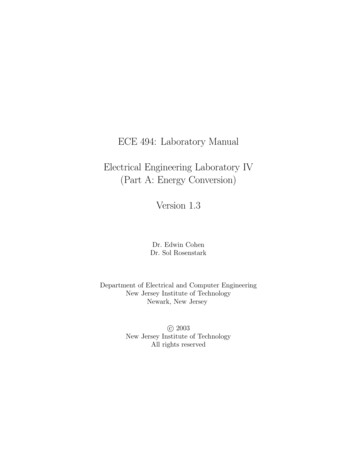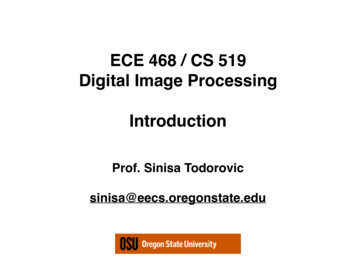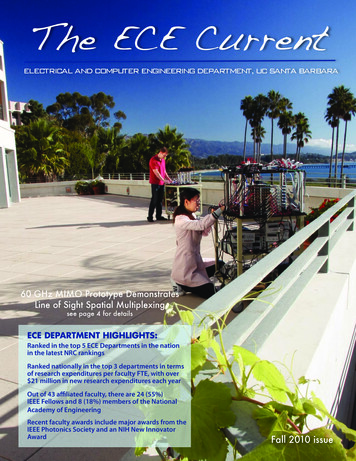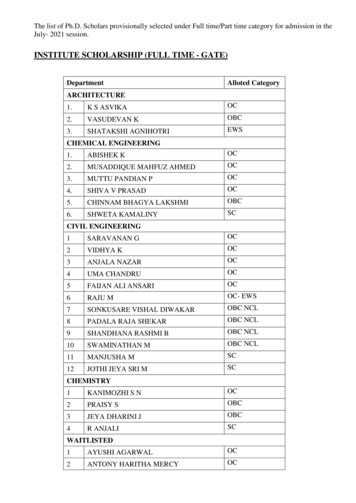
Transcription
ECE 453 – Introduction toComputer NetworksLecture 3 – Physical Layer II1Physical LayerServices – transmit bits from sender toreceiver.Transmission media Guided: twisted pair, coax, fiberUnguided (wireless): radio, microwave, infraredExamples of communication networks Public switched telephone systemCable televisionMobile telephone system2Communication SatellitesBig microwave repeater in the skyBent pipe Incoming signal (upward beam) Æ transpondersÆ amplification Æ rebroadcast (downward beam)Where to put satellites (orbital slot)? Orbital period (Kepler’s law)Van Allen beltsWhich b/w to use (b/w slot)?Footprint and spot beam31
Different Satellites4Principal Satellite Bands by ITU5A ComparisonGEOMEOLEO(Geostationary)(MediumEarth Orbit)(Low-Earth Orbit)Altitude35,800 km18,000 km750 kmOrbitalperiod24 hrs6 hrs90 minsRTT270 ms35-85ms1-7msRecentdevelopmentVSAT1962, TelstarApplicationSatellite TVIridium 1990 (66)Globalstar (48)Teledesic 2005 (30)24 GPSInternet, data, voice, paging,navigation62
Low-Earth Orbit Satellites IridiumMotorola’s Iridium project (1990) Launch 77 LEO’s Æ 66Altitude: 750 km six necklaces around the earth1628 moving cells cover the earthOne satellite every 32 degrees of latitudeApplication Targeted at satellite telephone users in odd spacesData, voice, paging, navigation7(a)(b)LEO - TeledesicTargeted at bandwidth hungry InternetusersYear 200530 satellitesKa bandPacket-switching in spaceUplink: 100 Mbps, downlink: 720 Mbps8LEO - Globalstar(a) Relaying in space.(b) Relaying on the ground.93
Satellite vs. Fibers10Public Switched TelephoneSystemStructure of the Telephone SystemThe Local Loop: Modems, ADSLTrunks and MultiplexingSwitching11Structure of the TelephoneSystem(a) Fully-interconnected network (1876)(b) Centralized switch (1878)(c) Two-level hierarchy.124
Structure of the TelephoneSystem (2)Digital fiber opticsAnalog twisted pair13The Local Loop: Modems, ADSL,and Wireless14Modems - ModulationSampling rate:2400 baud lineNumber ofsamples persecond155
Modems - Constellation Diagrams(a) QPSK.(b) QAM-16.(c) QAM-64.16Modems – With Error Correction128 pts(a)(b)(a) V.32 for 9600 bps.(b) V.32 bis for 14,400 bps (fax)17Theoretical Limits - ModemV.34: 28,800 bps (12 bits/sample)V.34 bis: 33,600bps (14 bits/sample)Why does standard modem stop at33.6kbps? Theoretical limit 35kbps56 kbps downstream (why 56 kbps?)186
Digital Subscriber Lines19Digital Subscriber Lines (2)A typical ADSL equipment configuration.20Cable Television Community Antenna Television Internet over Cable Spectrum Allocation Cable Modems ADSL versus Cable217
Community AntennaTelevisionAn early cable television system.22Internet over CableCable television23Internet over Telephone LineThe fixed telephone system.248
Spectrum AllocationFrequency allocation in atypical cable TV systemused for Internet access25ComparisonDSL (1M – 10Mbps) (FDM) Asymmetric digital subscriber lineHigh-speed downstream channel (Download): 50kHz 1MHz, 8MMedium-speed upstream channel (Upload): 4kHz 50kHz, 1MTraditional telephone line: 0 4kHzCable Modem (HFC) (1M – 10Mbps) Use cable (cable company becomes ISP)26The Mobile Telephone SystemFirst-Generation Mobile Phones:Analog VoiceSecond-Generation Mobile Phones:Digital VoiceThird-Generation Mobile Phones:Digital Voice and Data279
Mobile Telephone SystemUS The first system ismandated by the gov.Digital generation:incompatiblePhone number (mixed)(pay for incoming call)Europe Different countrieshave their own systemDigital generation:GSMSpecial area code(caller pays)Prepaid cardNo monthly charge281st Generation – AMPS(Advanced Mobile Phone System)Bell Lab (1982)Frequency reuse in nearby cellsBase station – radio relayMTSO (mobile telephone switching office)Handoff (300 ms)Each cell: 10-20 km293010
AMPS - Channel Categories832 full-duplex channels 824 – 849 MHz simplex channels869-894 MHz simplex channelsEach simplex channel 30 kHz wideThe channels are divided into four categories: Control (base to mobile) to manage the system(21)Paging (base to mobile) to alert users to calls forthemAccess (bidirectional) for call setup and channelassignmentData (bidirectional) for voice, fax, or data31AMPS – Call ManagementcallerMTSOAccess channelControl channelChannel nr.MTSOcalleePaging channelAccess channelSwitch channelCallee’s homeMTSOMTSO322nd Generation – D-AMPSChannel b/w: 30kHzHandset-side digitization and compression 3 users share a freq. Pair (TDM)Each pair supports 25 frames/secEach frame is divided into 6 time slotsMAHO (Mobile Assisted HandOff)3311
2nd Generation - GSMChannel b/w: 200 kHz (FDM) 890.2MHz – 959.8MHz124 pairs of simplex channelsHold 8 users in each channel (TDM)Used around the world except US and Japan342nd Generation - CDMANeither FDM nor TDM is usedCDM (code division multiplexing)B/w used: 1.25MHzEach bit time is subdivided into m“chips”Each station is assigned a unique m-bitcode as a “chip sequence”Normally, 64 or 128 chips per bit35CDMA – Code Division MultipleAccess3612
Third-Generation Mobile Phones:Digital Voice and DataBasic services an IMT-2000 network shouldprovide High-quality voice transmissionMessaging (replace e-mail, fax, SMS, chat, etc.)Multimedia (music, videos, films, TV, etc.)Internet access (web surfing, w/multimedia.)IMT – International Mobile TelecommunicationProposals W-CDMA (Ericsson) (5MHz) Æ UMTSCDMA2000 (Qualcomm) (5MHz)3713
Iridium 1990 (66) Globalstar (48) Teledesic 2005 (30) VSAT 1962, Telstar Recent developmen t RTT 270 ms 35-85ms 1-7ms Orbital 24 hrs 6 hrs 90 mins period Altitude 35,800 km 18,000 km 750 km LEO (Low-Earth Orbit) MEO (Medium-Earth Orbit) GEO (Geostationary) 3 7 Low-Earth Orbit Satellites - Iridium











